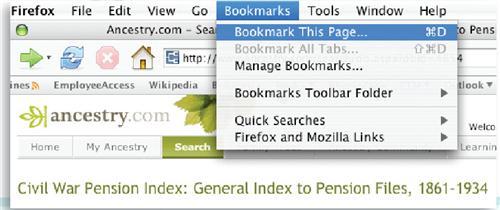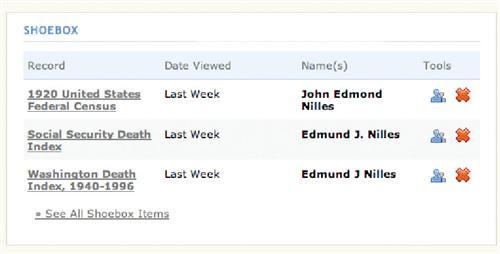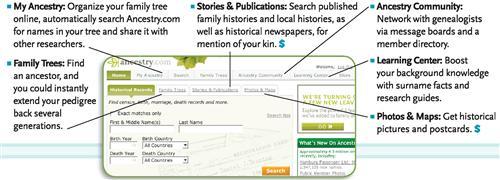Sign up for the Family Tree Newsletter Plus, you’ll receive our 10 Essential Genealogy Research Forms PDF as a special thank you!
Get Your Free Genealogy Forms
"*" indicates required fields

Admit it. You return again and again to the popular genealogy Web sites – FamilySearch, USGenWeb, RootsWeb and others – looking for clues about your ancestors. If you’re repeating the same searches but not finding much, it’s time to give your technique an overhaul.
We’ve taken a fresh look at seven familiar sites, examined their search options, and even figured out how to use Google <google.com> to probe them more efficiently. So get out of that rut – and finally find your ancestors – with these “hacks” for effectively mining the Internet’s most-frequented family history stops.
Ancestry.com <ancestry.com>
You’ll find oodles of important family history records at genealogy’s biggest subscription site, including the entire run of US censuses and immigrant passenger lists. Even though the search interface is regularly refined and improved, finding your ancestors among the billions of name son this sprawling site isn’t always easy-unless you understand your options:
Conquer global vs. targeted searching. You can search the hundreds of databases in Ancestry.com’s Historical Records collection at once from the home page: Just fill in some combination of first and middle names, last name, country, state and year range. That’s a great way to cover a lot of ground at once, but if you’re searching for a common name, you’ll probably get a lot of bad matches. One of the best ways to focus your results is to individually search the most-relevant databases. Most Ancestry.com databases have customized search forms so you can do a more-precise search-and weed out false matches.
To find relevant databases, click the Search tab. You can browse for databases by place or record type. Another option: Use the Ancestry Database Card Catalog (also under the Search tab). Search for databases by record type, location and year range, or enter just a surname in the Keyword(s) field to find family histories. You also can browse for a title word, such as a place name or a surname, by selecting the first letter of the word and working your way down until you well out the whole word.
Master regular vs. exact matches. Ancestry.com automatically looks for exact and near matches, so you usually don’t need to repeat a search with different terms. Just fill out the search form wit has much information as you have, such as a full name and approximate years of birth and death, and the best matches will appear at the top of the results.
If you want to do a more precise search, check the box for Exact Matches Only. You might start with one or two search terms, such as a last name and a place. If you get too many results, add more terms to narrow the search; if you get too few, drop one or more terms to broaden the search. To find alternate spellings, select the Soundex match or use wildcards. An asterisk represents zero to six characters, so rob*son finds Robson, Robertson and Robinson. A question mark represents one character, so peter?n matches both Peterson and Petersen. But keep in mind you can’t use a wildcard for the first three letters of a word.
Access Ancestry.com for free.
You can get many resources on Ancestry.com for free if you’re willing to give up the convenience of access from home. Many public libraries subscribe to Ancestry Library Edition (keep in mind it doesn’t include the Family and Local Histories Collection, the Historical Newspapers Collection, OneWorldTree, the Passenger and Immigration Lists Index, Biography and Genealogy Master Index, Freedman’s Bank Records or PERSI). You also can access Ancestry.com, except for Canadian data added since February 2006, for free at Church of Jesus Christ of Latter-day Saints Family History Centers.
Bookmark your favorite databases.
If you regularly use a particular database on Ancestry.com, add it to your Web browser’s Favorites list. Say you often search the Civil War Pension Index. Display the search page for this database and select Add to Favorites from the Favorites menu in Internet Explorer. Then you can by pass Ancestry.com’s home page and go directly to this search screen.

Clarify subscription options.
Be sure you know what you’re paying for: Click Subscribe on the upper right-hand corner of Ancestry.com’s home page to view the subscription plans. You can opt for just the US collections or the whole shebang, including records from the United Kingdom, Ireland and other countries. Remember: All subscriptions renew automatically.
Determine what’s there — and what’s where.
Don’t limit yourself to the databases. Ancestry.com offers many other tools to enhance your family history research, all grouped under tabs. ($ indicates subscription required.).
Earmark your research finds.
When you uncover relevant database records and document images, Ancestry.com lets you save them to your “shoebox” – an area of My Ancestry that gives you one-click access to material you may want to view again. In the record-image viewer, you also can print a document, save it to your computer or e-mail it to a friend (for free).

ADVERTISEMENT


